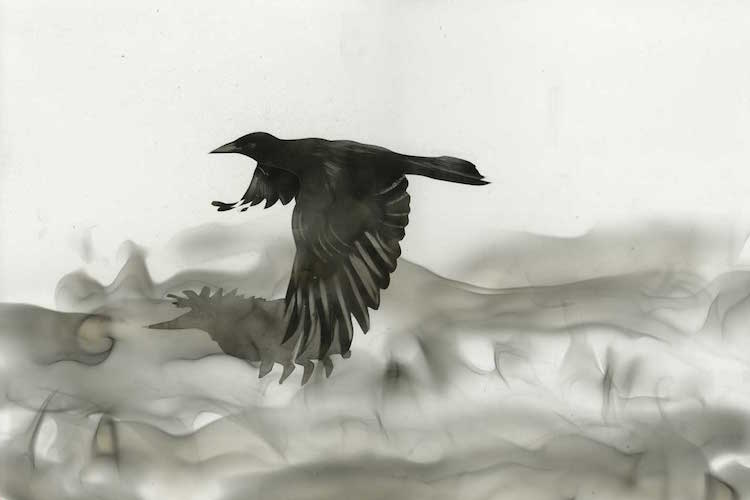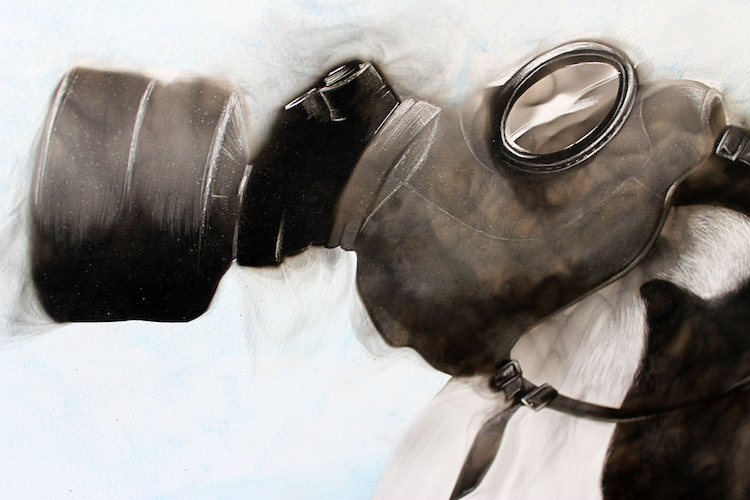The Canadian artist, Steven Spazuk, has achieved to make a space for himself in the art world thanks to his peculiar technique, the fumage.
In order to give shape to his creations, this author uses the candles’ soot. With it, he creates vague forms over a surface and then he transforms them into figures. With pencils, bird feathers, paint brushes, pins and other tools, he engraves the lines and patterns that, with the soot leftovers, will become a specific object.
Spazuk has given Horse an interview where he has explained, among other things, what inspires him to use fire in his works:
“Fire is very inspiring for me. It burns down, warms up and lights, but it can also bring pain and death. Therefore, its symbolic meaning changes a lot depending on the context. I use it mainly to talk about the fragility of life. Exploring that fragility is the key of my work as a fire artist” he says.
Therefore, it’s a totally spontaneous process. When he brings the flame closer to the paper, he doesn’t know the final result. However, shapes reveal to Steven Spazuk’s visionary mind, and what started as a strike of luck just needs his finishing touches to become a perfectly outline silhouette.
“Spontaneity and chance are the heart and soul of my creative process. I don’t censor, I open myself to the experience”.
Steven Spazuk declares that the idea of using fire came up in a dream and, since then, he devoted his life to perfect this technique. He explains it like this:
I had a dream in 2001. In this dream I was in a gallery looking a black and white landscape made with fire. Then, I completely understood the technique. I woke up the next morning, I remembered the dream and I started to experiment. I haven’t stopped since that moment.
It’s already been 17 years since his beginnings back in 2001. What he first realised was that he should use a type of card stock thicker than usual in order to avoid the flame to set fire. He didn’t succeed in his first attempts. Once he learnt how to paint with the flames, his efforts focused on attaching the paints in order to avoid the soot from vanishing.
Putting soot in the paper is a very fragile process, it can be easily alter with any contact. Anything touching the soot will leave a trail. The main challenge of painting with fire is that fragility. I always hold my breath when I work in something because if anything touches the surface it will leave a trail. I have to be very careful and sure that I don’t touch parts of the painting that I don’t want to change
The difficulty of the technique forces him to work with pieces made of paper on a reduced scale in order to handle them without any problem. For that reason, when he does bigger compositions, he overlaps a quantity of paper one after the other in such a way that they create a unified images resembling a collage.
The level of detail is immense if we think about his unusual working tool. However, Steven Spazuk performs it masterfully. In the portraits, one can notice every hair, every wrinkle, every little imperfection or irregularity that makes the people represented unique. In his “Bird series”, the accuracy of his work when outlining the bird plumage immediately catches the eye.
Smoke is always present in Steven Spazuk’s work, it’s more than just a tool for him. The wavy and sinuous forms introduce the spectator into the artist’s world. The elements seem to come out of the shadows, as if he had cast a spell.
Creativity and imagination is what defines this artist, who discovered a new way of expressing his art. Mystery and magic. Using just two colours, white for the background and black to outline the designs, he achieves to create his own universe.
He has just arrived from the Art Basel Fair in Miami and he tell us his experience:
This has been my first visit to Miami during the Art Basel week. My work has been already exhibited there in the last two years, but I had never been there. To be surrounded by so many good art in the same place is a very inspiring experience
Steven Spazuk has reinterpreted our HORSE logo and the result is surprising
Translated by Raquel Sanchez














